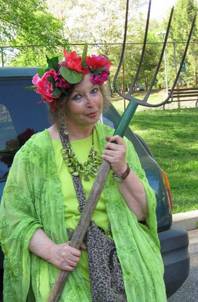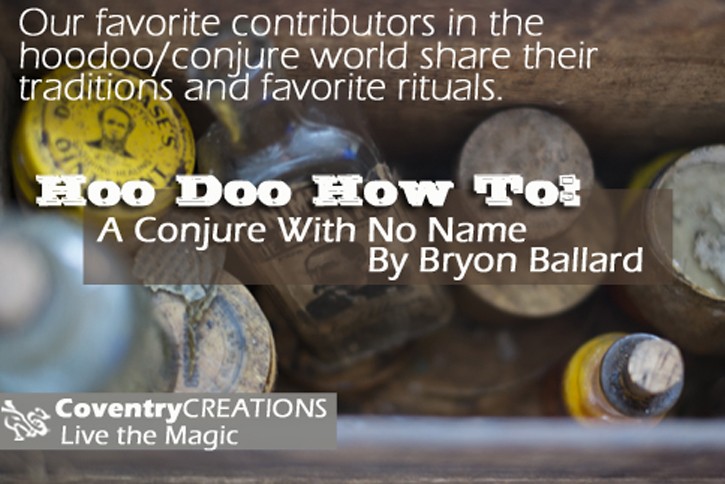A Conjure with No Name
By Byron Ballard
Words are important. Language is important. How we use it, how it morphs depending on the situation and the company, how it can be used as both balm and bomb—this is endlessly fascinating to those of us who are self-described word nerds.
In modern Western Pagan communities, we relentlessly parse our language in an attempt to be clear and to make our definitions stick. There are words that evolve over time—like the word “gay”—and there are other words that are deliberately and consciously re-defined in an act of reclamation, like the word “witch”.
This dedication is undergirded by a harsh reality: many experiences simply can’t be described in words. They needs smells, and touches. They require an experiential understanding that can only be kenned by the doing of a thing.
When it comes to what I do, the sort of practical magic I both teach and perform, it doesn’t have a name, not really. At some point, I will have enough time to research who tacked “Appalachian Granny Magic” onto this old weird cultural practice but until then I call it “Hillfolks’ Hoodoo”when I’m teaching. It morphs into “Appalachian folk magic and healing modalities” when my audience is academic.
It comes from three major sources—British, German and Cherokee—and is a living tradition that is changing all the time. The people who brought it into my little corner of the world were staunchly Protestant Christian, and still are. They don’t call it “magic” at all and are offended when anyone suggests that it is anything but the shaped power of God. It is standard operating procedure to always disavow any personal ability but to insist that the healer is an agent of the Divine, a channel through whom the Will and Love of Jesus is made manifest in some of the poorest of God’s children in the southern Appalachians.
The practitioners have often been older, experienced women and they have been called “granny women” and herb or yarb doctors. One of the earliest mentions I’ve found is from The Southern Highlander and His Homeland by John C. Campbell. Campbell was one of the flock of “song catchers” that arrived in the southern highlands at the beginning of the last century and there is a wonderful school named after him, where you can learn all sorts of beautiful and needful skills. (https://www.folkschool.org/)
Here’s what Campbell had to say:
There is something magnificent in many of the older women with their stern theology -- part mysticism, part fatalism -- and their deepunderstanding of life. ..."Granny" -- and one may be a grandmother young in the mountains -- if she has survived the labor and tribulation of her younger days, has gained a freedom and a place of irresponsible authority in the home hardly rivaled by the men of the family. ...Though superstitious she has a fund of common sense, and she is a shrewd judge of character. Insickness she is the first to be consulted, for she is generally somethingof an herb doctor, and her advice is sought by the young people of half the countryside in all things from a love affair to putting a new web inthe loom. (John C. Campbell, The Southern Highlander and his Homeland, Russell Sage foundation, 1921, pg. 140.https://archive.org/details/southernhighland00camp)
It is a stern theology, to be sure. They are joyous at funerals because the beloved one has gone home to Jesus. They take trauma and tragedy in stride. They are tickled by the simplest things and count their blessings when they may. But they didn’t call what they did magic, and they still don’t. Their religion precludes that. They did and do sometimes call the people who have these gifts “witches” but even that is getting rarer as the religions get more strict.
Though I share much of the cultural trappings of the southern highlands, I certainly don’t share the religious sensibilities. I was raised unchurched, from Methodist stock, and formally became a practicing Pagan in the 70s. I do call it magic and call myself a witch because the restrictions of that Protestant dogma don’t apply to my tree-hugging dirt worship.
And this thing I do, it doesn’t really have a name. Back in the day, the neighbors in a cove would know who to go to for doctoring, for water-finding, for midwifery. They were practicing old techniques that didn’t require the sick person to get to a doctor, even if one was nearby. What I continue to learn, even as I practice it, is rural peasant healing, social engineering and justice work.
Appalachian folk magic—like all folk magic systems—is based on using available materials to achieve the desired end result. In this formerly-isolated culture, there is a general suspicion of outsiders, of the Law. From catching babies, to distributing justice, to burying the dead these old systems serve poor people, people without recourse to urban centers of either healing or the law.
I call it hillfolks’ hoodoo because that suits me. I may sometimes call it conjure or rootwork when I am talking to other practitioners. The folks that still practice it in the remote fastnesses of these old mountains, though, don’t call it anything at all.

H. Byron Ballard, BA, MFA, is a ritualist, teacher, speaker and writer. She has served as a featured speaker and teacher at Sacred Space Conference, Pagan Unity Festival, Pagan Spirit Gathering, Southeast Wise Women’s Herbal Conference, Glastonbury Goddess Conference, FaerieFest and other gatherings. She serves as elder priestess at Mother Grove Goddess Temple, a church devoted to the many faces of the Divine Feminine, where she teaches religious education and leads rituals.
Her essays are featured in several anthologies, and She blogs as “Asheville’s Village Witch” (myvillagewitch.wordpress.com) and as The Village Witch for Witches andPagans Magazine (witchesandpagans.com/The-Village-Witch), where she is also a regular columnist. Her pamphlet “Back to the Garden: a Handbook for New Pagans“ has been widely distributed and her first book “Staubs and Ditchwater: an Introduction to Hillfolks Hoodoo” (Silver Rings Press) debuted in June 2012. Byron is currently at work on the companion volume “Asfidity and Mad-Stones” and “Earth Works: Eight Ceremonies for a Changing Planet”. Contact her at www.myvillagewitch.com, [email protected]

